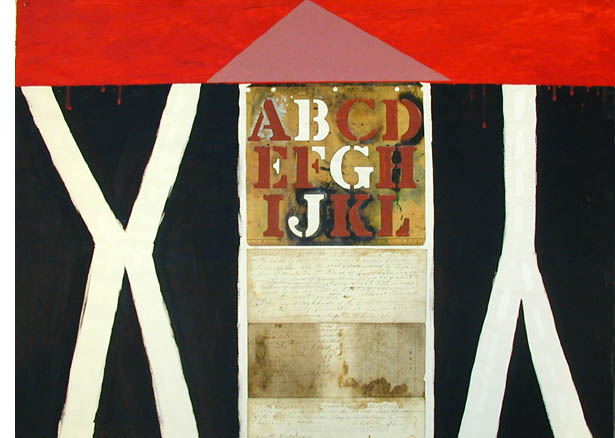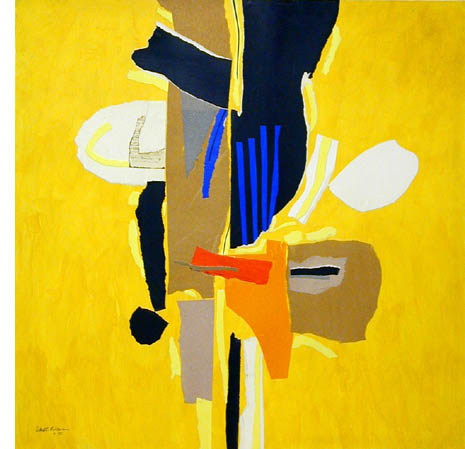Distributed March 26, 2003
For Immediate Release
News Service Contact: Mary Jo Curtis
April 12 to May 26, 2003
Bell Gallery to exhibit Walter Feldman: The Work of Five Decades
The David Winton Bell Gallery will host a new exhibition, Walter Feldman: The Work of Five Decades, April 12 to May 26, 2003, celebrating the artistic and educational endeavors of a long-time faculty member. An opening reception is scheduled for April 11, 2003, at 5:30 p.m. in the gallery. The reception and the exhibit are free and open to the public.
PROVIDENCE, R.I. — The David Winton Bell Gallery will celebrate the artistic and educational accomplishments of one of Brown University’s most senior faculty members in its new exhibition, Walter Feldman: The Work of Five Decades.
The exhibit opens April 12 and continues through May 26, 2003, in the Bell Gallery of the List Art Center. An opening reception is scheduled for April 11 at 5:30 p.m. in the gallery. At 6 p.m. in adjacent List auditorium, noted art critic Donald Kuspit will present a slide lecture on Feldman’s work. The reception and exhibition are both free and open to the public.

Letters and words
Feldman loves to work with words, says a faculty colleague. He makes you want to read them and feel them. Alphabet House (1981), acrylic and collage on paper, 22 x 30. Photo courtesy of the artist.
Walter Feldman has taught at Brown since 1953. He was born in 1925 in Lynn, Mass., and attended Yale University, where he studied with Willem de Kooning and Josef Albers.
The exhibition spans Feldman’s career, beginning with a macabre image of a skeleton-faced soldier – done in 1946 shortly after he returned from infantry service in World War II – and continuing through his most recent book, The Ballad of Rodger Young, completed earlier this year. Between the two, Feldman has created works in a wide range of materials: paintings in egg tempera, gouache, oil and acrylic; pen and ink drawings; mosaics and stained glass; silk screens, woodcuts, etchings and engravings; and mixed media sculpture, collage and hand-set letterpress books.

Multi media
During the last five decades, Feldman has worked with many materials. Signals, (1982) was done in oil with collage on Masonite. Photo courtesy of the artist.
Perhaps closest to the artist’s heart are the works from Ziggurat Press, which Feldman founded in 1990. This body of work includes handsome, small-edition handmade books, created in concert with distinguished contemporary poets – many of whom have taught at Brown, including C. D. Wright, Michael Harper, James Schevill, George Monteiro and Denise Levertov – as well as beautiful personal works, such as Summer 1989. This one-of-a-kind book is bound in tapa cloth and includes exquisite pen-and-ink drawings of trees near Feldman’s country home, interspersed with pages containing skins shed by “David,” a snake who shared the property with the Feldman family.
Certain recurrent themes and subjects can be found in Feldman’s work – Don Quixote, Mexico, pre-Columbian art, letters, stele, Genesis and the effects of war. A Packet of Letters (1989) tells the story of the artist’s mother, who learned to write so that she could “succor her youngest son who was far, far away, frightened and very lonely.” Aleksander Kulisiewicz’s Songs of the Concentration Camps, recorded after his release from the Sachsenhausen concentration camp, provides the text for Feldman’s Lager Lieder, published in 1989.
Feldman’s work has been included in numerous one-person and group exhibitions at major museums, including the Museum of Modern Art in New York City, the Corcoran Gallery in Washington, D.C., the Institute of Contemporary Arts in London, the Institute of Contemporary Art in Boston and the Brooklyn Museum in New York. He has created several public art pieces in Providence, including mosaics at Temple Beth-El, Miriam Hospital and Temple Emanu-El and stained glass windows at the Sugarman Memorial Chapel.
The exhibition catalog includes tributes by C. D. Wright and Barton Levi St. Armand, as well as an essay by Donald Kuspit that delineates Feldman’s place in contemporary art practice.
“Walter Feldman’s sensibility seems tactile in the extreme,” said Wright, a professor of English. “He likes to work with words, but he especially likes to work with words by making of them serious impressions. He makes of them something you want to read, of course, but also something you want to feel.”
“Walter Feldman’s art reminds us that while poetry and song may be the charity of the imagination, it is the strong hand of the master which provides the steady faith and hope that unerringly impresses solid form on fleeting and ephemeral content,” observed St. Armand, a professor of American civilization.
Walter Feldman: The Work of Five Decades is supported by Brown University’s Office of the President, Office of the Provost and Department of Visual Art; by Peter Gidwitz; and by a donation in memory of Ady Mittlemann. The David Winton Bell Gallery is located in the List Art Center, 64 College St. It is open weekdays from 11 a.m. to 4 p.m. and weekends from 1 to 4 p.m. For more information, call (401) 863-2932.
######





